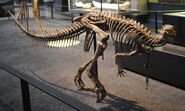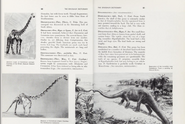
Dysalotosaurus
Dysalotosaurus lettowvorbecki (meaning ‘uncatchable lizard’) is a genus of herbivorous dinosaur. It was a dryosaurid, and its fossils have been found in late Kimmeridgian age-rocks (Late Jurassic) of the Tendaguru Formation, Tanzania. The type species of Dysalotosaurus is D. lettowvorbecki. Dysalotosaurus was named by Virchow in 1919. It has long been referred to approximate contemporary Dryosaurus but newer studies reject this synonymy.
In 2011 paleontologists Florian Witzmann and Oliver Hampe from the Museum für Naturkunde and colleagues discovered that deformations of some Dysalotosaurus bones were likely caused by a viral infection similar to Paget’s disease of bone. This is the oldest evidence of viral infection known to science. The best perserved skeletons were destroyed during the World War II. Some of the best remains are preserved only as drawings and sketches. From the specimens which have survived until today, only one (marked dy I) retains approximately 50% of the skeleton.
The known fossils of Dysalotosaurus are of animals of different ages, with the smallest reaching only 0,7 meters and the largest specimen 4 meters in length. A developmental study of Tom Huebner and Oliver Rauhut (2010), suggests the change of characteristics during the growth are: young animals, when compared to adult animals, for example, have shorter snouts and larger eye sockets (orbits). The dentition shows more age-related changes: young animals only had 10 teeth per lower and upper jaw, while there were 13 teeth in adult animals. The teeth were also in the course of development, becoming wider with age. The front three teeth of each jaw half were in pups significantly slimmer than the other teeth – such difference is not seen in adult specimens. These changes could indicate that it was juveniles who were omnivorous, and the animals became pure herbivores in the adult stage of development.
A juvenile skull of Dysalotosaurus lettowvorbecki, a basal iguanodontian from the Middle Dinosaur Member (Kimmeridgian) of the Tendaguru Beds (Tanzania), is described and reconstructed in detail. Further preparation and computed tomography scans have uncovered additional and formerly unknown skull elements, especially of the lower jaw. The reconstruction of the skull reveals ontogenetic differences to earlier reconstructions, which were based on specimens of relatively older individuals. The most notable ontogenetic changes in Dysalotosaurus are a relative lengthening of the muzzle, a decrease in the relative size of the orbit, and a straightening of the posterior skull roof. Additionally, ontogenetic variations were found in many single elements of the skull, all of which reflect the three main tendencies described above. Furthermore, there might have been an ontogenetic change in the diet, from omnivorous juveniles to fully herbivorous adults. The results of this study will help to evaluate ontogenetic stages in other ornithopods, and will shed light on a crucial stage of ornithopod evolution that culminated in the highly specialized and diverse hadrosaurs of the Cretaceous. Many of the evolutionary changes seen in this lineage can be attributed to paramorphism, and probably reflect a perfection of the adaptation towards an obligatory herbivorous diet.
Scientific classification
Kingdom: Animalia
Phylum: Chordata
Class: Reptilia
Superorder: Dinosauria
Order: Ornithischia
Suborder: Ornithopoda
Family: Dryosauridae
Genus: Dysalotosaurus
Species: D. lettowvorbecki Virchow, 1919


